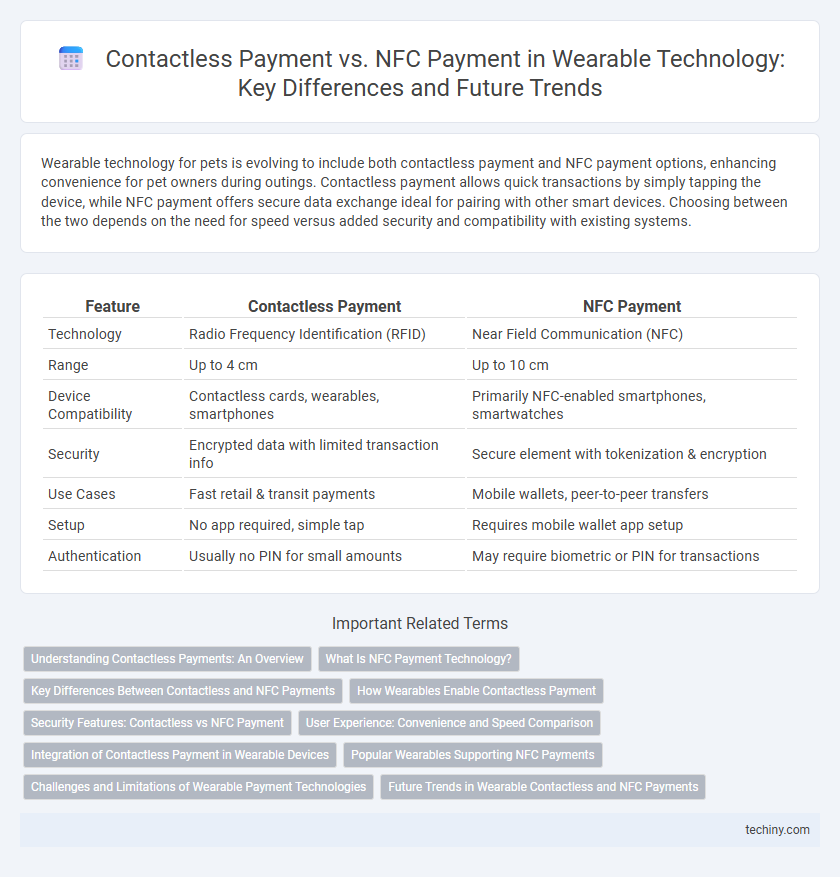Wearable technology for pets is evolving to include both contactless payment and NFC payment options, enhancing convenience for pet owners during outings. Contactless payment allows quick transactions by simply tapping the device, while NFC payment offers secure data exchange ideal for pairing with other smart devices. Choosing between the two depends on the need for speed versus added security and compatibility with existing systems.
Table of Comparison
| Feature | Contactless Payment | NFC Payment |
|---|---|---|
| Technology | Radio Frequency Identification (RFID) | Near Field Communication (NFC) |
| Range | Up to 4 cm | Up to 10 cm |
| Device Compatibility | Contactless cards, wearables, smartphones | Primarily NFC-enabled smartphones, smartwatches |
| Security | Encrypted data with limited transaction info | Secure element with tokenization & encryption |
| Use Cases | Fast retail & transit payments | Mobile wallets, peer-to-peer transfers |
| Setup | No app required, simple tap | Requires mobile wallet app setup |
| Authentication | Usually no PIN for small amounts | May require biometric or PIN for transactions |
Understanding Contactless Payments: An Overview
Contactless payments enable secure transactions through radio-frequency identification (RFID) or near-field communication (NFC) technology embedded in wearable devices, allowing users to simply tap or wave their gadgets near compatible terminals. NFC payment specifically relies on short-range wireless communication standards operating within 4 cm to transmit payment data instantly between the wearable and the point-of-sale system. This technology enhances speed, security, and convenience in mobile commerce by eliminating the need for physical cards or cash during transactions.
What Is NFC Payment Technology?
NFC payment technology uses Near Field Communication to enable secure, wireless transactions between a wearable device and a payment terminal by simply tapping them within close proximity, typically 4 cm or less. This technology facilitates fast, contactless payments by transmitting encrypted payment data via radio waves, eliminating the need for physical cards or cash. NFC payments are widely integrated into smartwatches and fitness trackers, enhancing convenience and security for users during everyday purchases.
Key Differences Between Contactless and NFC Payments
Contactless payment uses radio frequency identification (RFID) to transmit payment information securely without physical contact, supporting cards and wearable devices. NFC payment is a subset of contactless technology operating at close range (4 cm or less), enabling direct communication between NFC-enabled devices like smartphones and payment terminals. The key difference lies in NFC's two-way communication capability, allowing data exchange beyond simple payment authentication, whereas contactless payments primarily focus on one-way transmission from card or wearable to terminal.
How Wearables Enable Contactless Payment
Wearable devices equipped with NFC chips enable seamless contactless payment by securely transmitting payment information to terminals without physical contact. These wearables leverage tokenization and biometric authentication to enhance transaction security and user convenience. Integration with mobile wallets and banking apps further streamlines payment processes, making wearable technology a pivotal element in contactless financial transactions.
Security Features: Contactless vs NFC Payment
Contactless payment and NFC payment both utilize secure encryption methods, but NFC offers a higher level of security through its short-range communication and mutual authentication protocols. Contactless payments rely on tokenization to protect card information from unauthorized access during transactions. NFC technology also supports biometric authentication, adding an extra layer of protection compared to standard contactless payments.
User Experience: Convenience and Speed Comparison
Contactless payment via wearables offers seamless transactions by simply tapping the device near a terminal, reducing checkout time and eliminating the need to handle cash or cards. NFC payment technology enhances user experience by enabling quick, secure communication between the wearable and payment terminal, supporting instant authentication and transaction approval. Both methods prioritize efficiency, but NFC payments often provide faster processing speeds and broader compatibility with various payment systems, boosting overall convenience for users.
Integration of Contactless Payment in Wearable Devices
Contactless payment technology in wearable devices leverages NFC (Near Field Communication) to enable seamless, secure transactions without physical card interaction. Integration focuses on embedding NFC chips and secure element hardware within smartwatches, fitness trackers, and rings, ensuring fast communication with payment terminals. This advancement enhances user convenience by combining mobility and transaction security, driving the widespread adoption of wearable payment solutions.
Popular Wearables Supporting NFC Payments
Popular wearables supporting NFC payments include Apple Watch, Samsung Galaxy Watch, and Fitbit Versa, enabling secure and fast contactless transactions. These devices integrate NFC technology to facilitate payments via platforms like Apple Pay, Samsung Pay, and Fitbit Pay without physical card use. NFC payment-enabled wearables enhance user convenience and safety by allowing seamless, on-the-go purchases at compatible terminals worldwide.
Challenges and Limitations of Wearable Payment Technologies
Wearable payment technologies face challenges such as limited battery life, which restricts continuous use and convenience. Security vulnerabilities pose risks due to potential unauthorized access or data breaches in contactless and NFC transactions. Compatibility issues with various payment terminals and a lack of universal standards also hinder widespread adoption and seamless user experience.
Future Trends in Wearable Contactless and NFC Payments
Wearable contactless payments and NFC payment technologies are rapidly evolving, driven by advancements in secure biometric authentication and ultra-low power consumption chips. The integration of AI and machine learning is enhancing fraud detection and transaction speed, while 5G connectivity is enabling real-time payment processing in wearables. Future trends emphasize seamless user experiences through multi-device interoperability and expanding acceptance across global retail and transportation networks.
Contactless Payment vs NFC Payment Infographic

 techiny.com
techiny.com